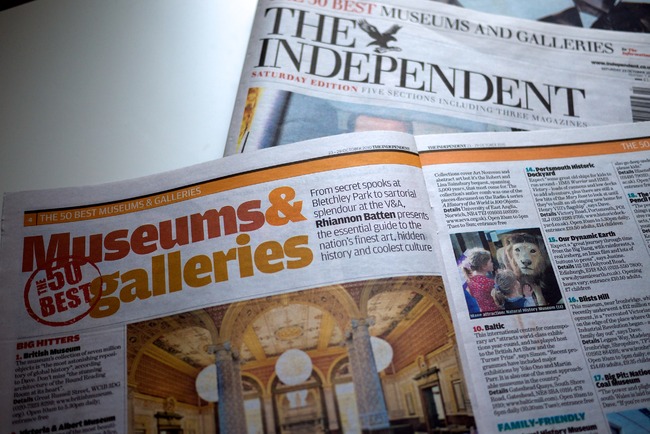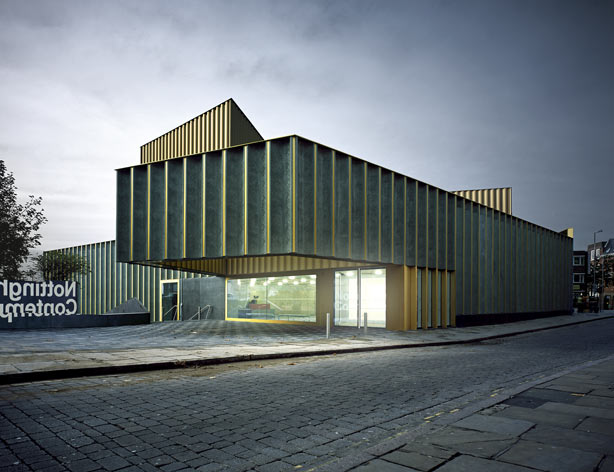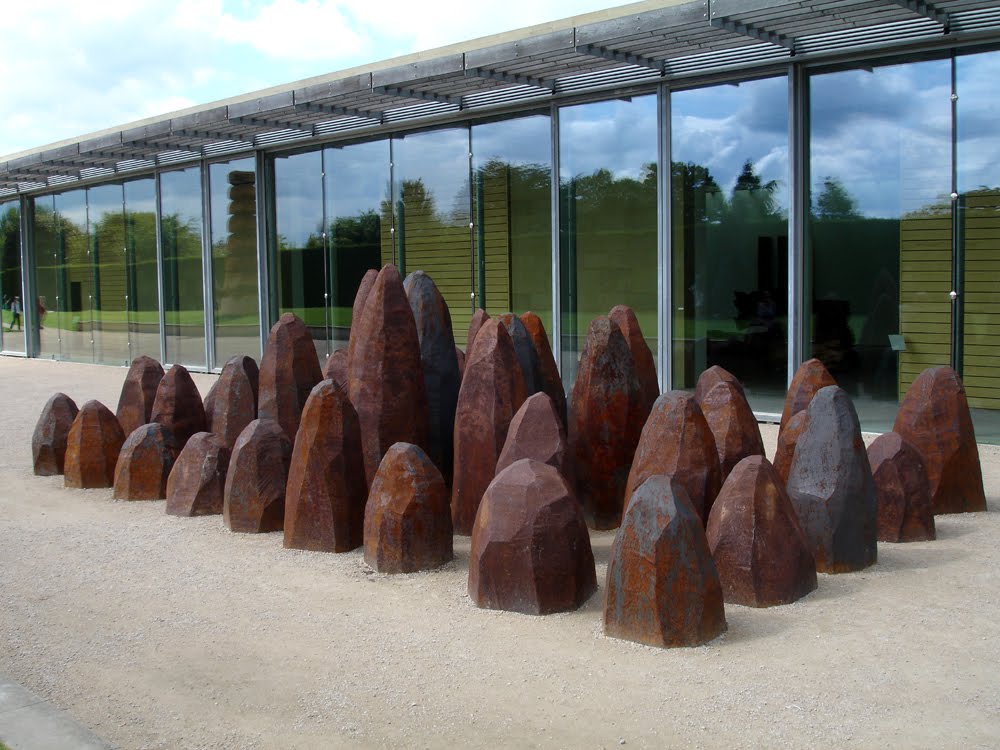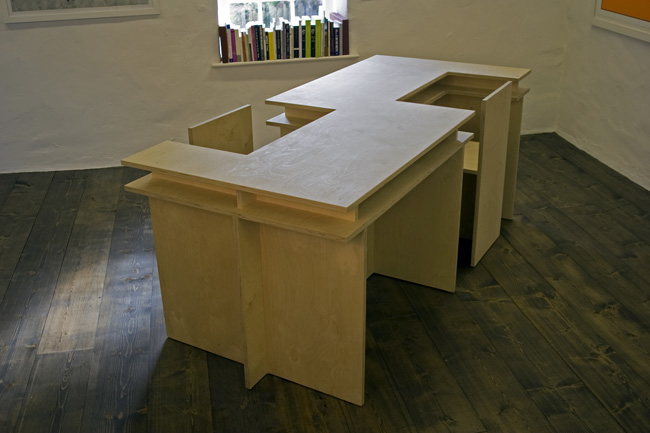Hebemedia Makes The Indy 50 Best... Museums And Galleries
 Friday, November 5, 2010 at 1:58PM
Friday, November 5, 2010 at 1:58PM  The Independent's Information supplement containing a guide to the Best 50 Galleries and Museums, 10 of which were picked by our very own Simon Zimmerman. Click the image to visit the online version of the guide.
The Independent's Information supplement containing a guide to the Best 50 Galleries and Museums, 10 of which were picked by our very own Simon Zimmerman. Click the image to visit the online version of the guide.
On the 23rd of October 2010 the Independent published an "Indy Best" with a guide to the top 50 galleries and museums in Great Britain. When we say Hebe Media made the list, we mean it quite literally... Read on to find out more!
Whilst we here at Hebe Media frown on shameful self-publisicts, we couldn't overlook that fact that 10 of the "50 Best" were picked by our very own office mate, Simon Zimmerman. Simon was invited to join the panel to make a selection for the guide because of his long term commitment to the arts: working for Arts Council England for almost a decade, and helping artists and arts organisations around the country.
Simon was asked to select two venues in each of five categories. "It was incredibly difficult to make a choice", says Simon. "I've been extremely privileged in my work to be able to visit many of our national and regional galleries and museums, as well as many of the artist-led and temporary spaces that exist. There is just so much to be proud of in the country, and I wanted to celebrate all of it. However, the challenge was to pick out 10 of the best, and that is what I have attempted to do here."
We've included the full text submitted by Simon, for each of his 10 venues. For the full list of 50, please click the image above and you will be redirected to The Independent's own website...
Big-hitters
BALTIC, Gateshead

BALTIC attracts world-class exhibitions year-round, and has played host to the British Art Show and the Turner Prize. Recent exhibitions include major shows by Yoko Ono, Jenny Holzer, Malcolm McLaren, Martin Parr and Cornelia Parker. It is an international centre for contemporary art and one of the friendliest and most approachable museums in the country.
Whitechapel, London
The jewel in the crown of London’s East End, Whitechapel is recognised around the world as a touchstone of contemporary art. Its doors have been open for more than 100 years, and in that time it has shown work by modern masters, from Picasso to Pollock. In more recent times, a masterful expansion of its galleries has enabled the Whitechapel to host major shows by contemporaries, like last year’s ‘Talking to Strangers’ by Sophie Calle.
Family friendly
New Art Gallery Walsall
Britain is a world leader in gallery education, and New Art Gallery Walsall is an example of why. In the first ten years of being open to the public more than 48,000 school children visited its galleries, and 23,000 people of all ages participated in one of its many educational activities. For family explorers, young and old, there is a unique interactive gallery space called Disco, and there are multi sensory sessions for parents to spend time with babies too.
Nottingham Contemporary

The iconic Nottingham Contemporary is one of the most exciting gallery spaces in the UK, and has attracted more than 200,000 visitors since it opened at the end of last year. It already has a strong track record of offering well considered programmes for people of all ages, and over the Summer of 2010 it pushed the boat out with a programme of free activities for families, children and teenagers, including a 12 metre tall interactive photo booth inspired by the recent Diane Arbus exhibition.
Specialist
Yorkshire Sculpture Park, Wakefield
 Image from: http://hapsical.blogspot.com/2010/09/artist-david-nash.htmlYorkshire Sculpture Park’s spectacular landscape, and award winning gallery spaces each play their own part in making this one of the few places in the world able to host major, large-scale sculpture exhibitions like the current review of Welsh sculptor, David Nash’s 40-year career. With the stunning Hepworth Gallery (also in Wakefield) opening in 2011, and the Henry Moore Institute in the heart of Leeds’s cultural quarter, Yorkshire is celebrating its reputation as the birthplace of modern sculpture.
Image from: http://hapsical.blogspot.com/2010/09/artist-david-nash.htmlYorkshire Sculpture Park’s spectacular landscape, and award winning gallery spaces each play their own part in making this one of the few places in the world able to host major, large-scale sculpture exhibitions like the current review of Welsh sculptor, David Nash’s 40-year career. With the stunning Hepworth Gallery (also in Wakefield) opening in 2011, and the Henry Moore Institute in the heart of Leeds’s cultural quarter, Yorkshire is celebrating its reputation as the birthplace of modern sculpture.
FACT (Foundation for Art and Creative Technology), Liverpool
The future is digital! The team at FACT know this and are dedicated to delivering outstanding and thought provoking exhibition programmes, for people of all ages who want to engage with the possibilities of tomorrow’s digital and interactive art, film and media landscape.
Small but perfectly formed
Shandy Hall, Coxwold
Formerly the home of celebrated writer Laurence Sterne, and now a museum dedicated to his legacy and continuing contribution to the arts, Shandy Hall is nestled in the picturesque village of Coxwold, North Yorkshire. Through exhibitions and artists’ residencies, the museum seeks to explore how the experimental spirit of previous generations of artists, like Sterne, can help us to unlock the work of contemporaries and vice versa. The current exhibition, The Perverse Library, is the first of its kind in Britain, and contains works of ‘conceptual writing’ by Kathy Acker, Kenneth Goldsmith, Pavel Buchler and others, from a generation of artists who have sought a radical reconsideration of the relationship between literature and the visual arts.
Artsway, Sway
The South East is a rich hive of contemporary art activity and set in The New Forrest National Park, Artsway is one of the cornerstones. It began life as the vision of a group of local artists, working from self-made studios in an abandoned old coach house, for a high quality exhibition space. Now a purpose-built and architecturally important gallery, Artsway is best known for commissioning new work; hosting residencies that push the development of artistic practice; and showing work by well-known and emerging artists, including Richard Billingham, Anne Hardy, Jordan Baseman, Alex Frost and Gayle Chong Kwan. Since 2005, Artsway has been re-presenting commissioned work at the Venice Biennial, and has built an international reputation for artistic excellence.
Alternative
Grizedale Arts, Grizedale
 Grizedale Arts is based in the central Lake District, just round the corner from John Ruskin’s final resting place, and is committed to exploring how contemporary art and artists (the Grizedale Arts alumni is a who’s who of contemporary art) can contribute to the social, cultural and economic context within which the organisation operates. Strictly speaking, this is not a gallery or a museum. However, its groundbreaking approach might just provide a model for the cultural institutions of tomorrow.
Grizedale Arts is based in the central Lake District, just round the corner from John Ruskin’s final resting place, and is committed to exploring how contemporary art and artists (the Grizedale Arts alumni is a who’s who of contemporary art) can contribute to the social, cultural and economic context within which the organisation operates. Strictly speaking, this is not a gallery or a museum. However, its groundbreaking approach might just provide a model for the cultural institutions of tomorrow.
Simon asked us to include this short video made by Juneau Projects, and commissioned by Grizedale.
The Study Room, Live Art Development Agency, London
The protagonists of body centred performance and Live Art have been the producers of some of the most significant documents and artefacts of contemporary art. Indeed, the document has become a kind of site for performance. The Live Art Development Agency has been something of an expert hunter-gatherer in this field and the free, open access Study Room provides a gateway into this provocative and challenging world.
Click here to visit the Independent's online version of the guide...








